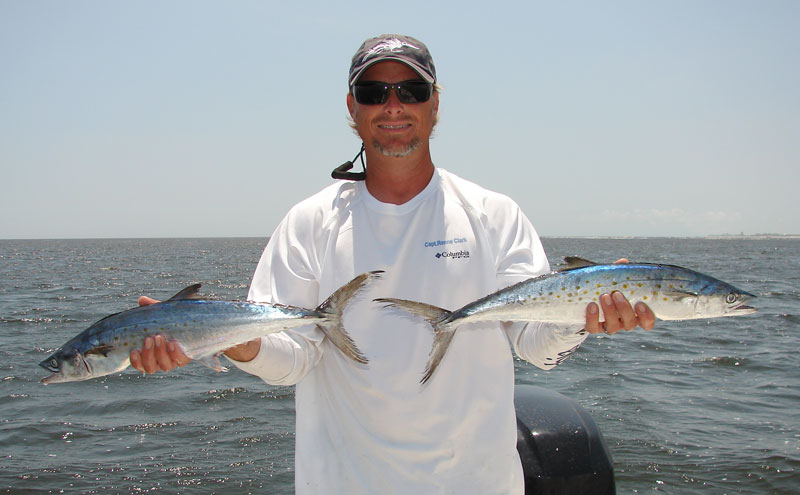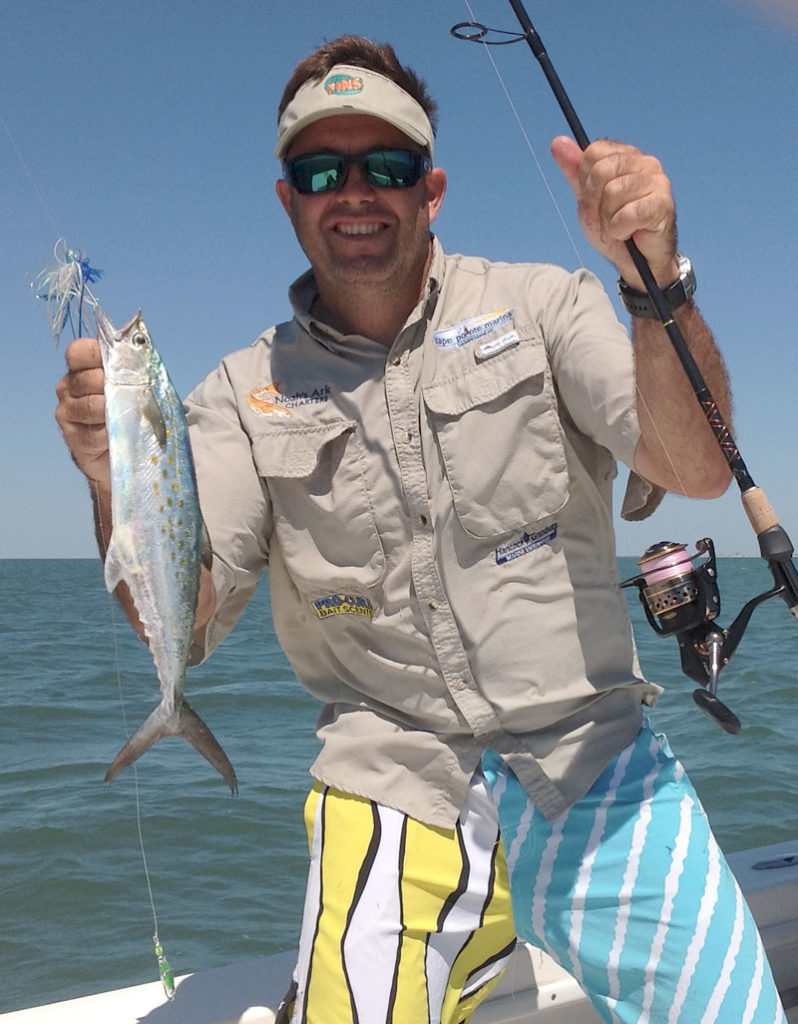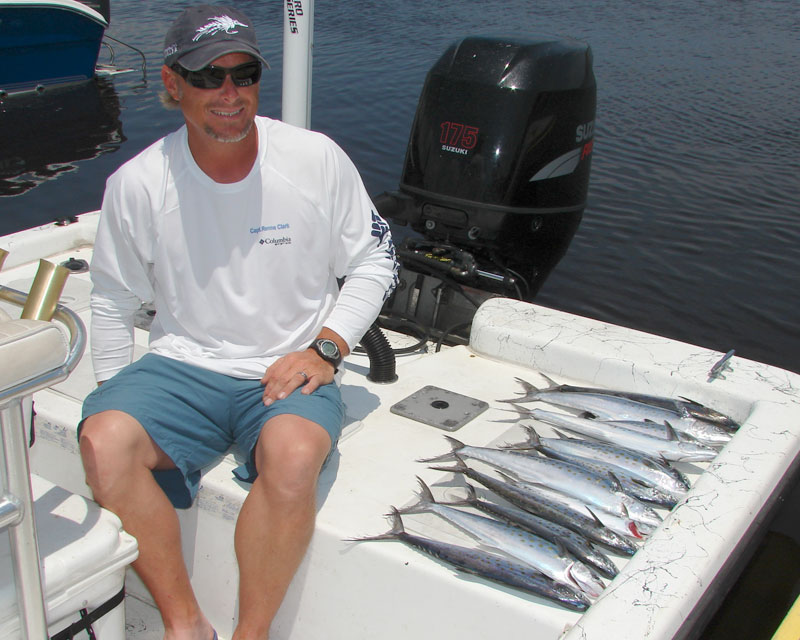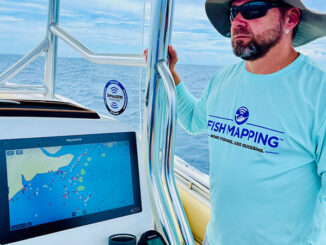
Spanish mackerel tips for the dog days of summer
Spanish mackerel are one of the most-prominent and most-popular fish off the coast of the Carolinas. One of the smaller members of the mackerel family, they are a coastal pelagic fish, primarily found in the ocean from just beyond the surf out a few miles. And they have a pleasant, mild flavor.
They sometimes follow baitfish inside inlets and are caught in larger sounds and rivers. The Carolinas manage them with a daily creel limit of 15, and on many days, that limit comes quickly.
Spanish mackerel are usually feeding and easy to catch, which helps boost their popularity. However, sometimes they develop a piscatorial version of lockjaw and don’t even look at baits and lures they usually attack with abandon.
So how do you bring dinner home when Spanish aren’t cooperating, when speaking their language is tough? Here goes….
Once the water warms into the 80s, Spanish typically feed hard and with abandon early in the morning and late in the afternoon. During the middle of the day, they often chase small silverside minnows on the surface. When they are chasing the small silversides, they often appear allergic to the same lures that caught them earlier. A very general suggestion for when this happens is to go smaller and retrieve faster.
Size makes a big difference
The primary difference between the baitfish that Spanish mackerels prefer early or late and during the middle of the day is size.
Silversides are much smaller, and Spanish seem to key in on smaller baits in the brighter light. They will readily show you what they are feeding on by regurgitating their most-recent meal on the deck of the boat or in the fish box. Once a fishermen sees the size of their preferred meal, they should match it as best they can.

Noah Lynk of Noah’s Ark Charters in Harkers Island, N.C., uses a Mackerel Duster rig he developed — a commercial version is now produced by Clarkspoon. This pairs a 1/8-ounce silver head, a mylar duster about 18 to 24 inches in front of a No. 00 Clarkspoon on a tandem rig. Lynk uses a 2/0 silver hook and various colors for the dusters, with primarily silver Clarkspoons.
“I like to fish mackerel dusters on the surface with no weights,” said Lynk (www.noahsarkfishingcharters.com). “They skip along the surface like fleeing baitfish, and I believe that helps excite the Spanish and produces reaction strikes. Sometimes, Spanish hit the duster and sometimes the Clarkspoon — and occasionally both.
Don’t forget trolling
“I often also troll a Mackerel Duster or two below the surface behind small planers or trolling sinkers,” Lynk said. “Occasionally, these will outfish the surface lines. But most of the time, the surface lines catch the great majority of the fish. A great thing about fishing these rigs on the surface with no weight is they can be trolled on lighter outfits. And the fishermen get to fight the fish, not a planer or sinker. It really is a lot more fun.”
Lynk said the biggest difference between his personal rig and the version made by Clarkspoon is that his is made using 20- to 30-pound fluorocarbon or mono leader. The production rig uses 45-pound coated, stranded wire. The production rig is more durable. But Lynk believes his catches more fish. The negative of the non-wire leader is the sharp teeth of Spanish can bite through it, and he loses more lures. This is a trade-off he is willing to make to keep his customers busy catching fish.
Multi-hook rigs also work well for Spanish mackerel
Guide Rennie Clark of Tournament Trail Charters in Carolina Beach, N.C., likes to troll Mackerel Tree rigs made by Clarkspoon and Sea Striker. These multiple-hook rigs use several small pieces of surgical tubing or flash Mylar on gold hooks in front of a Clarkspoon or jig. The smaller pieces of tubing and Mylar wraps are similar in size to the silversides.
“I like the Mackerel Tree rigs at any time,” said Clark (www.CaptRen.com). “They catch fish early in the day when Spanish are hitting larger baits. And they still work when they begin chasing smaller baits. There is a larger lure behind them for when a larger fish, looking for a larger bait, swims up. It’s a good mixture, and I troll them both on the surface and below it.”
The late Pete Allred of Pete’s Tackle in Morehead City, N.C., often gave impromptu Spanish mackerel seminars to inquisitive fishermen in his shop. He heralded trolling speck rigs as the simplest way for beginning fishermen to catch Spanish mackerel when they were feeding on the smaller baitfish and ignoring the usual lures. Speck rigs are simply a pair of bucktails tied on a mono leader, and they encompass a variety of sizes from about 1/16- up to 1/4-ounce.
Have a mixture of sizes available
Lighter bucktails are small, and they get larger as they get heavier. This makes it easy to match the size of the baitfish the Spanish are eating on any particular day. Allred suggested having and trolling several sizes of speck rigs until it was clear that the Spanish preferred a certain size that day. He also suggested mixing sizes on the same rig to see if there was a preference that day.
Allred trolled his speck rigs well behind the boat; this works for any lure when Spanish are being finicky. The extra distance moves them away from the noise of the motor, and there are days Spanish can be very noise-shy. The longer line also uses the belly of the line dragging in the water to help hold the surface lures in the water and prevents them from skipping and jumping wildly.

Allred used to say that Spanish mackerel were also very tuned to feeding at the speed of the baitfish, and trolling too slowly was often as big a culprit in smaller catches as anything else. Spanish usually feed at a faster pace, and he suggested beginning at around 6 knots, then speeding up if they continued not to bite. Many times small lures trolled very quickly are just the ticket for catching lure-shy Spanish. Allred would often laugh when someone asked if this wasn’t too quick and respond that you wouldn’t outrun them if they wanted the lure.
Stay on the edges of Spanish mackerel schools
Lynk, Clark and Allred cautioned that it was important to troll around a school of feeding Spanish, not across or through them. The continual turn will pull the lures into the edge of the school and not spook them. Once spooked, they may dive and stop feeding. Running across or through the school will usually cause them to dive, and they may move and may not return to the surface.
Allred had another tip for when Spanish were spread throughout an area, rather than schooled. He said to troll through the area, making a series of 90-degree right and left turns. The turns change the speeds of the lures a little, and you can often see if it will help to speed up or slow down a little. When turning, the lures on the inside of the turn slow down, as they don’t have to cover as much water. The lures on the outside speed up to cover more distance. Allred said to match the speeds of the lines that were catching more.
These tips should help provide supper when the Spanish macks get finicky during the heat of summer. It isn’t expensive to give this a try and see for yourself. The proof is when your fish box fills while others remain frustrated.
Speak fluent Spanish
Spanish mackerel, Scomberomorus maculatus, are visitors to the coasts of both Carolinas from spring through fall. They arrive off South Carolina’s Lowcountry sometimes as early as late March and spread to North Carolina’s Outer Banks by early May. Once there, they stay into the fall before beginning to migrate back to Florida sometime in October.

They are a primary target of many fishermen, and their general willingness to bite has made them a favorite to introduce young fishermen to trolling in the ocean.
Spanish mackerel are much smaller than their popular cousins, king mackerel, averaging 1 to 3 pounds. North Carolina offers an outstanding catch citation for Spanish mackerel 6 pounds or heavier. The world and North Carolina state record is a 13-pound fish caught off Ocracoke, N.C. in 1987 by Robert Cranton. South Carolina’s state-record fish weighed 11 pounds and was caught off Myrtle Beach in 1983 by W. Deas, Jr.
Fast-growing, excellent table fare
According to Dr. Charles Manooch in his book, Fishes of the Southeastern United States, Spanish mackerel are fast growing. They may reach 12 to 15 inches in their first year. The minimum size for Spanish mackerel is 12 inches fork length (tip of the nose to the middle of the fork in the tail). Both sexes are capable of spawning by their second year. The population has remained stable since a downturn in the mid- to late 1980s.
Spanish mackerel are considered excellent table fare. They are easily filleted, and even smaller Spanish produce a pair of fillets that can be tastily prepared by grilling, frying, baking, broiling and steaming. Their flesh is light gray and contains the Omega 3 fatty acids complex that helps produce good cholesterol and lower bad cholesterol.





Be the first to comment